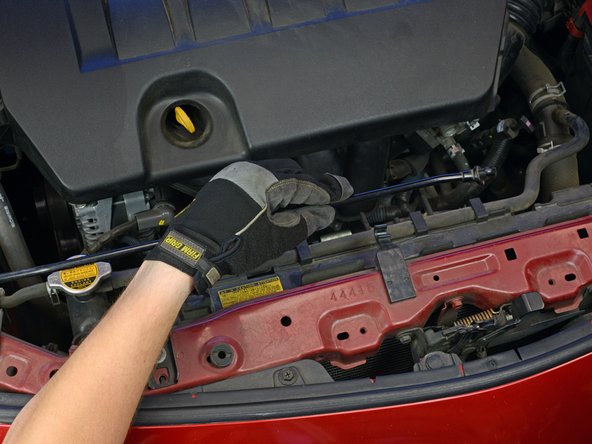Car and Truck Battery Replacement
ID: 66817
Description: If your car or truck won't start, it may be...
Steps:
- Before you begin, switch the ignition off and remove the key.
- Make sure the transmission is in Park (or first gear if you have a manual gearbox) and that the parking brake is engaged.
- Put on work gloves and safety goggles if you have them available.
- In addition to being dirty, the battery contains corrosive agents and may release flammable gases.
- Gloves can also help protect you from an unpleasant shock if you accidentally mishandle the battery.
- Most motor vehicle batteries are located in the engine bay, under the hood (a.k.a. bonnet). If your battery is located elsewhere, skip to Step 5.
- If you're not sure, simply continue reading.
- Pull the hood release lever. It's usually located inside the car, near the steering wheel.
- Raise the hood by simultaneously lifting and pressing up on the hood latch release (usually located beneath the front edge of the hood, near the center or center-right).
- At this point, depending on the vehicle, your hood may raise and support itself automatically.
- If not, use one hand to hold the hood open temporarily while securing the hood with the prop rod:
- Lift one end of the prop rod up or out to release it from the front area of the engine bay.
- Swing the end of the prop rod up and slide it into the cutout on the underside of the hood.
- Make sure the hood is well secured before you let go with your other hand, or it may fall and injure you.
- Locate the battery. It's normally rectangular and roughly 8-14" across.
- The battery may be easy to spot, or it may lie under a plastic cover—usually marked with positive (+) and/or negative (-) symbols.
- On some models, the battery may be located in the trunk—usually under or behind the trunk lining. Look around or consult your owner's manual.
- Using a correctly sized wrench or socket, loosen the nut/bolt securing the cable on the negative battery terminal.
- Always disconnect the negative cable first (before removing the positive cable).
- The negative terminal may be marked with a minus (-) symbol, or it may be unmarked. The positive terminal is almost always marked with a plus (+) symbol, often in red.
- If the nut or bolt spins without loosening, it may be necessary to counter-hold the opposite side with a second wrench or socket.
- Remove the cable from the negative battery terminal.
- When connecting the battery, it is advised to roughen up the battery terminals and clean the cable clamp beforehand.
- Upon reconnecting the battery, make sure to seal the pole connections with an appropriate terminal grease or terminal spray.
- Prevent the cable from making accidental contact with the terminal by pushing it aside and/or wrapping the cable clamp with a dry rag.
- Remove the insulating cover from the positive battery terminal (if one is present).
- Using a correctly sized wrench or socket, loosen the nut/bolt securing the cable on the positive battery terminal.
- If the nut or bolt spins without loosening, it may be necessary to counter-hold the opposite side with a second wrench or socket.
- Remove the cable from the positive battery terminal.
- During reassembly, be sure to reconnect and tighten the positive cable clamp first (before the negative cable clamp).
- Remove any bolts securing the battery.
- Remove any bars or brackets securing the battery.
- Remove the battery.
- A typical car battery can weigh 50 pounds or more, so lift carefully and get help if needed. Do not drop the battery, as this can release dangerous chemicals.
- If your battery cable clamps look dirty and/or corroded, clean them up with a wire brush and a mixture of water and baking soda before installing your new battery.
- To prevent corrosion in the future, coat the new battery's terminals with a little dielectric grease or petroleum jelly.
- Don't throw the old battery in the trash. Many auto parts stores and service stations will accept old batteries for free safe disposal.































